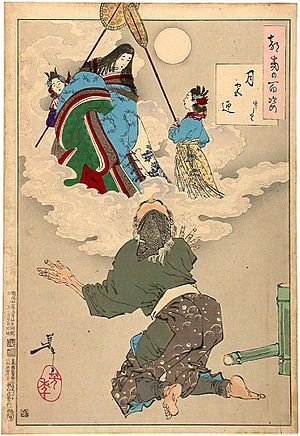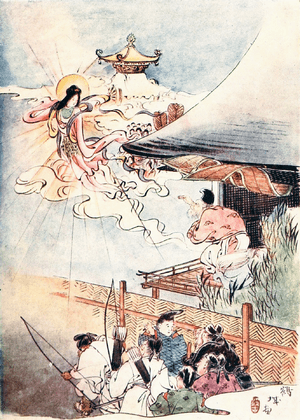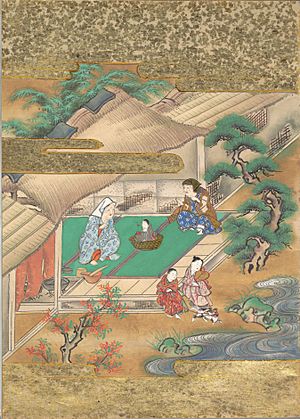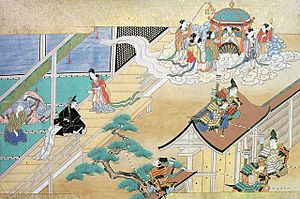The Tale of the Bamboo Cutter facts for kids
The Tale of the Bamboo Cutter (竹取物語 (Taketori Monogatari)) is a very old Japanese story. It's a type of story called a monogatari, which means a fictional tale in prose. No one knows who wrote it, but it's thought to be from the late 800s or early 900s. This makes it the oldest surviving monogatari!
The story is about a princess named Kaguya-hime. She comes from the Moon and is found as a baby inside a glowing bamboo stalk. As she grows up, she becomes incredibly beautiful. Five princes want to marry her, but she gives them impossible tasks to complete. She also catches the eye of the Emperor of Japan. In the end, Kaguya-hime reveals she's from the Moon and returns home. The story is also known as The Tale of Princess Kaguya (かぐや姫の物語 (Kaguya-hime no Monogatari)).
Contents
The Story of Princess Kaguya
One day, an old bamboo cutter named Taketori no Okina (which means "old bamboo harvester") was in the bamboo forest. He found a strange, shining bamboo stalk. When he cut it open, he was amazed to find a tiny baby, no bigger than his thumb!
The old man and his wife had no children. They decided to raise the baby as their own daughter. They named her Nayotake no Kaguya-hime, meaning "Shining Princess of the Young Bamboo." From that day on, every time the old man cut a bamboo stalk, he found a small piece of gold inside. The family quickly became very rich.
In just three months, Kaguya-hime grew from a baby into a beautiful young woman. The old man tried to keep her beauty a secret. But news of her amazing looks spread far and wide. Soon, many important men wanted to marry her.
The Impossible Tasks
Five noblemen were especially eager to marry Kaguya-hime. They were Prince Ishitsukuri, Prince Kuramochi, Minister Abe no Mimuraji, Grand Counselor Ōtomo no Miyuki, and Middle Counselor Isonokami no Marotari. They convinced the old man to let Kaguya-hime choose one of them.
Kaguya-hime wasn't interested in marrying any of them. So, she came up with five impossible tasks. She said she would marry the man who could bring her the special item she asked for. These items were:
- The stone begging bowl of the Buddha.
- A jeweled branch from the mythical island of Hōrai.
- A robe made from the skin of a Chinese fire-rat.
- A colored jewel from a dragon's neck.
- A cowry shell born from a swallow.
The first nobleman tried to trick her with a fake stone bowl. But Kaguya-hime knew it wasn't real because it didn't glow with holy light. The second nobleman had jewelers make a fake branch. But his trick was found out when the craftsmen came to collect their payment. The third nobleman bought a robe from China. But it burned when Kaguya-hime tested it with fire. The fourth nobleman went to find a dragon but gave up after a big storm. The fifth nobleman fell from a great height trying to get a shell from a swallow's nest. None of them succeeded.
The Emperor's Love
After the noblemen failed, the Emperor of Japan himself came to visit Kaguya-hime. He fell in love with her beauty and asked her to marry him. Even though he didn't have to do an impossible task, Kaguya-hime still said no. She told him she wasn't from his country and couldn't go to the palace.
She stayed in touch with the Emperor by sending letters. But she kept saying no to his marriage proposals. Three years passed with them only communicating through letters.
Return to the Moon
That summer, Kaguya-hime started crying whenever she looked at the full moon. Her adoptive parents were very worried, but she wouldn't tell them why. Her behavior became stranger and stranger. Finally, she revealed her secret: she was not from Earth. She had to return to her people on the Moon.
Some versions of the story say she was sent to Earth as a punishment. She had committed a crime and was sent to learn about human feelings. Other versions say she was sent to Earth for her safety during a war in the heavens. The gold her father found was money from the Moon people to pay for her care.
As the day of her return got closer, the Emperor sent his guards to protect her. He wanted to stop the Moon people from taking her away. But when heavenly beings came down to the bamboo cutter's house, a strange light blinded the guards.
Kaguya-hime announced that she loved her friends on Earth. But she had to go back to her true home on the Moon. She wrote sad letters to her parents and the Emperor. She gave her parents her own robe as a keepsake. She also gave a little bit of the elixir of immortality (a potion that makes you live forever) to the Emperor's guard.
As she gave it to him, a feather robe was placed on her shoulders. All her sadness and love for the people of Earth seemed to disappear. The group then rose into the sky, taking Kaguya-hime back to the Moon's Capital (Tsuki no Miyako (月の都)). Her earthly parents were left behind, crying.

Mount Fuji's Name
The old couple became very sad and fell ill. The Emperor's guard returned with Kaguya-hime's letter and the elixir. The Emperor was heartbroken when he read her letter. He asked his servants, "Which mountain is closest to Heaven?" One servant suggested the Great Mountain of Suruga Province.
The Emperor ordered his men to take Kaguya-hime's letter to the top of that mountain and burn it. He hoped his message would reach the distant princess. He also told them to burn the elixir of immortality. He didn't want to live forever if he couldn't see her.
Legend says that the word for immortality in Japanese, fushi, became the name of the mountain, Mount Fuji. It's also said that the Japanese characters for the mountain, 富士山 (which means "mountain abounding with warriors"), came from the Emperor's army climbing the mountain to follow his orders. People say that the smoke from the burning still rises from Mount Fuji to this day. (In the past, Mount Fuji was a much more active volcano and produced more smoke.)
Modern Connections
The Tale of the Bamboo Cutter is a very popular folk tale in Japan. It has been changed and retold in many modern ways, especially in Japanese pop culture like manga (Japanese comics) and anime (Japanese animation).
Some people even think The Tale of the Bamboo Cutter is an early example of science fiction. Think about it: Kaguya-hime is a princess from the Moon. She's an alien raised by humans on Earth. Then her alien family comes to take her back to the Moon. One old drawing from the story even shows a round flying machine that looks like a flying saucer! Kaguya's story also has some similarities to how a modern superhero gets their powers, like Superman.
Popular Adaptations
Many movies, TV shows, and games have been inspired by Kaguya-hime's story. Here are a few examples:
- Princess from the Moon – A live-action Japanese movie from 1987.
- The Tale of the Princess Kaguya – A beautiful anime film from 2013, made by Studio Ghibli.
- Queen Millennia – A Japanese manga and anime series from the 1980s.
- Sailor Moon – A very popular Japanese manga and anime series from the 1990s.
- Naruto – A popular Japanese manga and anime series that started in 1999.
- Ōkami – A video game from 2006.
- Tonikaku Kawaii – A manga and anime series that started in 2018.
See also
 In Spanish: El cuento del cortador de bambú para niños
In Spanish: El cuento del cortador de bambú para niños





